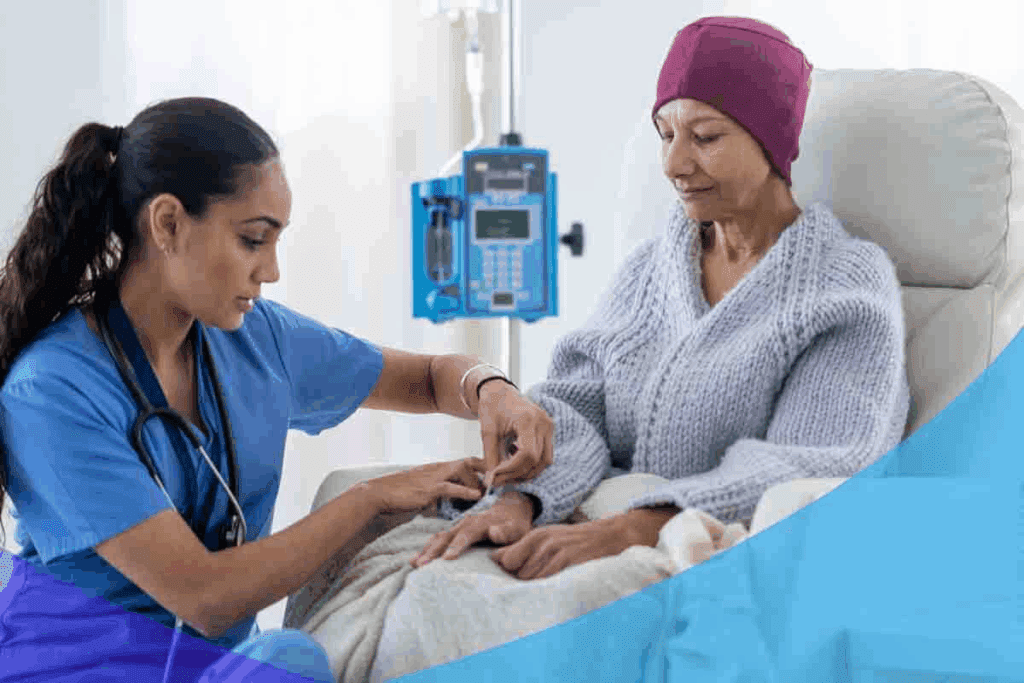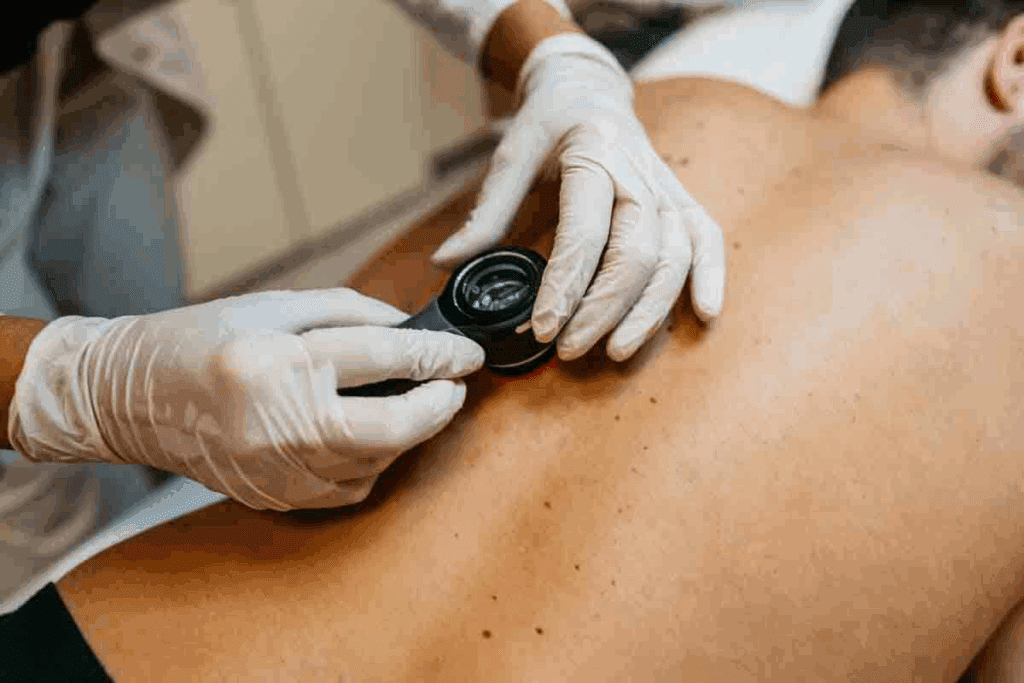Last Updated on November 17, 2025 by Ugurkan Demir

It’s important to know the signs of a blood clot to get help fast. A blood clot in the leg or arm can be very dangerous if not treated right away. We’ll talk about the main signs and symptoms to look out for.
Deep vein thrombosis (DVT) is a blood clot that can cause swelling, pain, warmth, and skin color changes. The American College of Obstetricians and Gynecologists says DVT is more common in pregnant women. Up to 90% of cases happen in the left leg. Knowing these symptoms is key for early treatment.

Blood clotting is key to stopping bleeding when we get hurt. But, it can be dangerous if it gets out of control. Understanding blood clots is key to spotting their signs and symptoms, which can save lives.
Blood clotting is a complex process. It involves many steps and factors. When a blood vessel gets hurt, the body first tightens the vessel to slow blood flow.
Then, platelets gather at the injury site, making a platelet plug. This plug gets stronger with a fibrin clot, thanks to chemical reactions and clotting factors.
The clotting process is carefully controlled. It happens only when needed and stays at the injury site. But, if it fails, it can lead to conditions like Deep Vein Thrombosis (DVT).
DVT happens when a clot forms in deep veins, usually in the legs. These clots are risky because they can travel to the lungs, causing a pulmonary embolism. Superficial clots, in contrast, form closer to the skin and are less dangerous but can cause discomfort.
It’s important to tell DVT apart from superficial clots. DVT needs more serious treatment, like anticoagulation therapy, while superficial clots might be managed more conservatively.
Blood clots can form anywhere in the body, but some places are more common. The legs are the most common spot for DVT, often in the calf or thigh. Immobility, from surgery, long trips, or illness, increases the risk of clots here.
Knowing where clots are likely to form and why helps in preventing them and spotting symptoms early. Being aware of the risks and signs can help get medical help quickly if a clot is suspected.

Blood clots can be very dangerous if they are not found early. They can form in different parts of the body. If they break loose, they can travel to important areas and cause serious problems.
Blood clots can lead to many issues, depending on where they form and if they move. Potential complications include pain, swelling, and limited mobility in the affected limb. But the biggest risks happen when the clot travels through the blood.
If a clot goes to the lungs, it can cause a pulmonary embolism (PE). This is a serious condition. The risk of PE is higher if the clot is big or if there are many clots.
A pulmonary embolism happens when a blood clot blocks blood flow in the lungs. This can cause severe chest pain, shortness of breath, and even death if not treated promptly. Symptoms of PE can come on suddenly, making quick medical help very important.
Even if a blood clot is not immediately dangerous, it can have lasting effects. For example, post-thrombotic syndrome (PTS) can occur after a deep vein thrombosis (DVT). It can cause chronic pain, swelling, and skin color changes in the affected limb.
It’s important to understand the dangers of undetected blood clots. Recognizing the signs and symptoms early can help prevent serious problems. By acting fast, individuals can get the help they need before it’s too late.
Knowing the signs of deep vein thrombosis (DVT) can save lives. Blood clots in the leg show up in different ways. We’ll look at the most common signs, so you know when to get help.
A throbbing pain in the calf or thigh is a key sign of a blood clot. This pain can feel dull or sharp. It might be constant or only happen when you stand or walk.
Key characteristics of clot-related pain include:
Swelling is another sign of a blood clot in the leg. The area might feel tight or heavy. This swelling is because the clot blocks blood flow.
It’s important to tell the difference between general swelling and swelling from a blood clot. Clot-related swelling often comes with warmth or redness.
The area with the blood clot might feel warmer than the rest. The skin could also look red or discolored. This is because the clot causes inflammation.
Changes in skin color and texture can also mean a blood clot. The skin might turn pale, blue-tinged, or red. Sometimes, it can itch or get a rash.
Here’s a summary of the common symptoms and their characteristics:
| Symptom | Characteristics |
| Throbbing Pain | Dull ache or sharp pain, constant or when standing/walking |
| Swelling | Tightness, heaviness, significant discomfort |
| Warmth and Redness | Warm to touch, red or discolored skin |
| Skin Changes | Pale, blue-tinged, or red skin, itchiness, rash |
It’s important to know the signs of a blood clot in the arm. This is key for getting help quickly and avoiding serious problems. The symptoms can be different from those in the legs.
Pain or tenderness in the upper arm is a main sign of a blood clot. This pain can feel like a dull ache or a sharp stab. It’s important to remember that this pain can stay the same or get worse when you move or touch your arm.
Swelling is another common sign, often with visible veins. The clot blocks blood flow, causing swelling and more visible veins. This swelling can be just around the clot or spread through the whole arm.
The skin around the clot may turn red or blue because of the blood buildup. It might also feel warm or hot. These signs show inflammation and poor blood flow.
A blood clot in the arm can make it hard to do daily tasks. You might feel weak or have less movement in the affected arm. In serious cases, you could need immediate medical help.
Blood clots can cause a lot of discomfort, but how it feels can vary a lot. We’ll look at the different kinds of pain from blood clots. We’ll also talk about how to tell if it’s from a clot or muscle pain. And when you should worry it’s a medical emergency.
The pain from a blood clot can feel different for everyone. Some people feel a constant cramp or soreness in their limb. Others might get a sharp pain suddenly.
The pain might always be there or only happen when you move or touch the limb.
Common descriptions of blood clot pain include:
Telling clot pain from muscle pain can be tricky. Both can hurt your limbs. But, there are some differences. Muscle pain usually spreads out and is tied to certain activities or injuries.
On the other hand, clot pain is more focused and doesn’t get better with rest or over-the-counter meds. If you have ongoing or severe pain in your limbs, you should see a doctor to figure out why.
In some cases, pain from a blood clot can mean a serious problem, like a pulmonary embolism (PE). If you have sudden, severe chest, arm, or leg pain, or trouble breathing, get help right away.
Knowing what blood clot pain feels like and when it’s serious is key. If you’re not sure about your pain, always talk to a doctor.
Knowing how to spot a blood clot is key to catching it early. We’ll look at what a blood clot looks and feels like. This will help you spot signs of trouble.
A blood clot can make a limb look different. It might swell up, and the skin could turn red or discolored. Sometimes, the skin might look pale or even bluish because of the clot blocking blood flow.
One patient said, “My leg looked like it had been inflated, and the skin was stretched tight.” These signs can mean you have a blood clot.
The area might feel warm or tender to the touch. People might feel heaviness or aching in their limb. The swelling can make the texture firmer, and it might hurt when pressed.
“I felt like my arm was on fire, and it was so tender that even a light touch was painful.” – Patient testimonial
People often say a blood clot feels like a throbbing or cramping pain. Others feel a persistent ache that doesn’t go away with rest. These feelings can be constant or change, sometimes getting worse over time.
Spotting these signs is important for getting medical help fast. If you think you have a blood clot, see a doctor right away for the right diagnosis and treatment.
Knowing the signs of a blood clot is key to getting help fast. Clots can form in legs, arms, and more. They can cause serious problems if not treated right away. Let’s look at the five main signs of a blood clot.
Pain is a common sign of a blood clot. The pain can feel like a cramp or soreness. It often starts in the calf or thigh.
The pain can be constant or only happen when standing or walking. Sometimes, the pain is mild and easy to ignore.
Doctors say the pain from a blood clot can be tricky. It might feel like muscle strain or other common issues. So, it’s important to watch for any unusual or ongoing pain.
Swelling is another big warning sign. A clot can block blood flow, causing fluid to build up. This leads to swelling and a feeling of tightness or heaviness.
The swelling can be just around the clot or spread further.
Color changes in the skin can mean a blood clot. The area might turn red, purple, or even blue (cyanosis) because of poor blood flow. Redness is often the first sign, along with warmth. In severe cases, the skin may look bluish because of oxygen lack.
“Color changes are a critical warning sign that should prompt immediate medical evaluation,” says a vascular specialist.
The area with a blood clot might feel warmer than the rest of the skin. This warmth comes from inflammation. The increased temperature is a subtle sign but very important.
In summary, knowing the five warning signs of a blood clot—pain, swelling, color changes, warmth, and tenderness—can save lives. If you or someone you know has these symptoms, getting medical help right away is vital.
Knowing the signs of a blood clot is key for early treatment. This can greatly improve your health. We’ll show you how to check yourself and why you should see a doctor for a proper diagnosis.
Start by looking at your legs and arms for any unusual signs. Check for swelling, redness, or warmth in one limb compared to the other. Also, look for tenderness or pain, mainly when standing or walking.
Gently feel the affected area to check for any unusual hardness or cord-like structures under the skin.
Self-examination is a good start, but it has its limits. Not all blood clots show obvious symptoms. Some may not cause discomfort until they become serious. So, if you think you have a blood clot, see a doctor right away.
“A blood clot can be life-threatening if it breaks loose and travels to the lungs, causing a pulmonary embolism. Early detection is key to preventing serious complications.”
Vascular Surgeon
Doctors use different tests to confirm a blood clot. The most common is ultrasound, which can see the clot and check blood flow. Other tests might include D-dimer blood tests, venography, or CT scans.
| Diagnostic Test | Purpose |
| Ultrasound | Visualize blood clots and assess blood flow. |
| D-dimer Blood Test | Measure substances in the blood that are produced when a clot dissolves. |
| Venography | Use X-rays and contrast dye to visualize veins. |
When you see a doctor, tell them everything you can. Describe your symptoms in detail, including when they started and what makes them better or worse. Also, tell them about any recent travel, surgeries, or times when you were very inactive.
Knowing the risk factors for blood clots is key to preventing them. Blood clots can form from many causes. Being aware of these can help lower your risk.
Some people are more likely to get blood clots. This includes those who don’t move much, have had surgery recently, or have certain health issues. For example, those with cancer or heart disease are at higher risk.
Changing your lifestyle can help lower your risk of blood clots. This includes staying active, keeping a healthy weight, and not smoking.
Key lifestyle modifications include:
For those at high risk, medical treatments may be needed. This can include medications that thin the blood and prevent clots.
Anticoagulant therapy is often used for those at high risk. It’s important to regularly check how well this treatment is working.
When traveling, it’s important to take steps to prevent blood clots. Drinking water, wearing compression stockings, and taking walks can help a lot.
To prevent blood clots every day, know the risk factors and stay active. Regular health check-ups can also help manage risks early.
It’s important to know the signs of a blood clot to get help quickly. We talked about symptoms like pain, swelling, and changes in skin color and temperature in the legs and arms.
If you notice these signs, don’t wait to see a doctor. Delaying can cause serious problems, like pulmonary embolism. Doctors usually treat blood clots with anticoagulation therapy to stop more clots.
If you think you have a blood clot, see a doctor right away. They will check you and decide the best treatment. Anticoagulation therapy is common, but sometimes more treatments are needed.
Knowing the risks and acting early can help prevent blood clots. Stay informed and look out for warning signs. Always seek medical help when you need it for your health.
Symptoms include throbbing pain and swelling in the leg. You might also notice warmth and skin discoloration. Tightness or heaviness in the leg is another sign.
Look out for upper arm pain and swelling. Visible veins and color changes are also signs. Difficulty moving the arm can indicate a blood clot.
Yes, it can be very painful. The pain feels like persistent cramping or soreness. It can get worse over time.
It causes swelling, skin discoloration, and warmth. The skin might feel tight or tender. Some people feel a heavy or aching sensation.
Look out for pain, swelling, and color changes. Warmth and redness are also warning signs. These symptoms can get worse over time.
You can check for swelling or skin discoloration yourself. But, it’s best not to try to diagnose yourself. Medical tests are needed to confirm a blood clot.
Risk factors include being inactive for a long time and having surgery. Certain medical conditions and family history also increase risk. Age, obesity, and smoking can also play a role.
Preventing blood clots involves regular exercise and staying hydrated. Avoiding prolonged inactivity is also key. For high-risk individuals, anticoagulation therapy may be necessary.
Tell your doctor about any symptoms like pain, swelling, or color changes. Share any risk factors or medical conditions. Your doctor will examine you and may order tests to confirm the diagnosis.
Treatment includes anticoagulation therapy to prevent the clot from growing. This reduces the risk of complications. In severe cases, thrombolysis or surgery may be needed.
Subscribe to our e-newsletter to stay informed about the latest innovations in the world of health and exclusive offers!